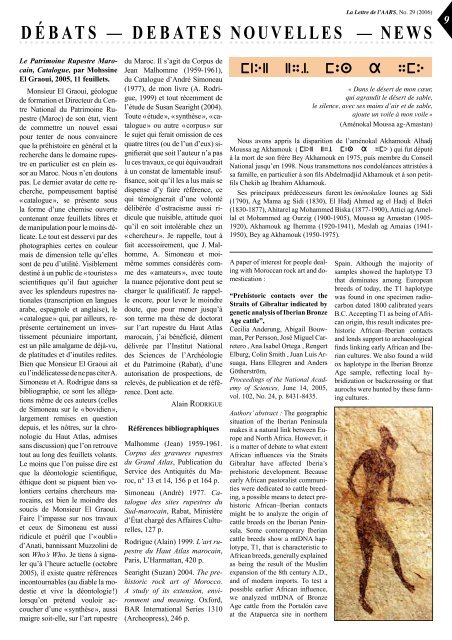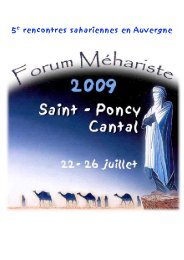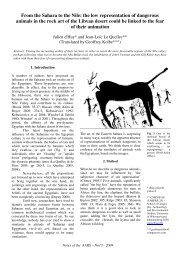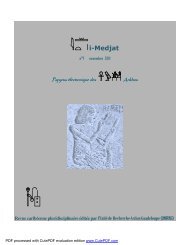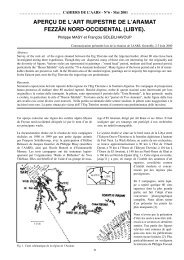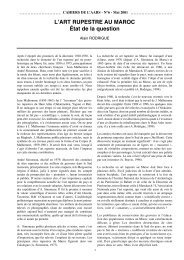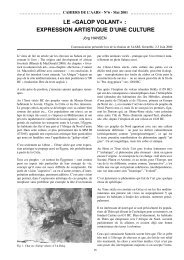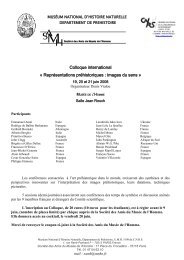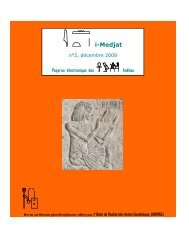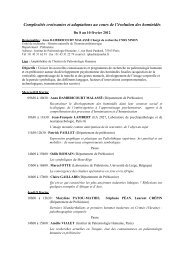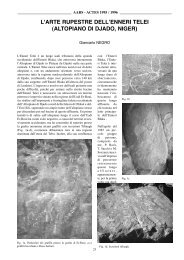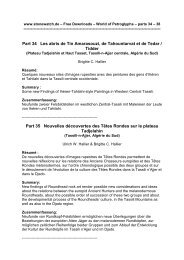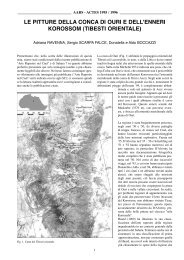lettre_ 29.pdf - Amis de l'Art rupestre saharien (AARS)
lettre_ 29.pdf - Amis de l'Art rupestre saharien (AARS)
lettre_ 29.pdf - Amis de l'Art rupestre saharien (AARS)
You also want an ePaper? Increase the reach of your titles
YUMPU automatically turns print PDFs into web optimized ePapers that Google loves.
D É b A T S — D e b A T e S<br />
Le Patrimoine Rupestre Marocain,<br />
Catalogue, par Mohssine<br />
el Graoui, 2005, 11 feuillets.<br />
Monsieur El Graoui, géologue<br />
<strong>de</strong> formation et Directeur du Centre<br />
National du Patrimoine Rupestre<br />
(Maroc) <strong>de</strong> son état, vient<br />
<strong>de</strong> commettre un nouvel essai<br />
pour tenter <strong>de</strong> nous convaincre<br />
que la préhistoire en général et la<br />
recherche dans le domaine <strong>rupestre</strong><br />
en particulier est en plein essor<br />
au Maroc. Nous n’en doutons<br />
pas. Le <strong>de</strong>rnier avatar <strong>de</strong> cette recherche,<br />
pompeusement baptisé<br />
«catalogue», se présente sous<br />
la forme d’une chemise ouverte<br />
contenant onze feuillets libres et<br />
<strong>de</strong> manipulation pour le moins délicate.<br />
Le tout est <strong>de</strong>sservi par <strong>de</strong>s<br />
photographies certes en couleur<br />
mais <strong>de</strong> dimension telle qu’elles<br />
sont <strong>de</strong> peu d’utilité. Visiblement<br />
<strong>de</strong>stiné à un public <strong>de</strong> «touristes»<br />
scientifiques qu’il faut aguicher<br />
avec les splen<strong>de</strong>urs <strong>rupestre</strong>s nationales<br />
(transcription en langues<br />
arabe, espagnole et anglaise), le<br />
«catalogue» qui, par ailleurs, représente<br />
certainement un investissement<br />
pécuniaire important,<br />
est un pâle amalgame <strong>de</strong> déjà-vu,<br />
<strong>de</strong> platitu<strong>de</strong>s et d’inutiles redites.<br />
Bien que Monsieur El Graoui ait<br />
eul’indélicatesse<strong>de</strong>nepasciterA.<br />
Simoneau et A. Rodrigue dans sa<br />
bibliographie, ce sont les allégations<br />
même <strong>de</strong> ces auteurs (celles<br />
<strong>de</strong> Simoneau sur le «bovidien»,<br />
largement remises en question<br />
<strong>de</strong>puis, et les nôtres, sur la chronologie<br />
du Haut Atlas, admises<br />
sans discussion) que l’on retrouve<br />
tout au long <strong>de</strong>s feuillets volants.<br />
Le moins que l’on puisse dire est<br />
que la déontologie scientifique,<br />
éthique dont se piquent bien volontiers<br />
certains chercheurs marocains,<br />
est bien le moindre <strong>de</strong>s<br />
soucis <strong>de</strong> Monsieur El Graoui.<br />
Faire l’impasse sur nos travaux<br />
et ceux <strong>de</strong> Simoneau est aussi<br />
ridicule et puéril que l’«oubli»<br />
d’Anati, bannissant Muzzolini <strong>de</strong><br />
son Who’s Who. Je tiens à signaler<br />
qu’à l’heure actuelle (octobre<br />
2005), il existe quatre références<br />
incontournables (au diable la mo<strong>de</strong>stie<br />
et vive la déontologie!)<br />
lorsqu’on prétend vouloir accoucher<br />
d’une «synthèse», aussi<br />
maigre soit-elle, sur l’art <strong>rupestre</strong><br />
du Maroc. Il s’agit du Corpus <strong>de</strong><br />
Jean Malhomme (1959-1961),<br />
du Catalogue d’André Simoneau<br />
(1977), <strong>de</strong> mon livre (A. Rodrigue,<br />
1999) et tout récemment <strong>de</strong><br />
l’étu<strong>de</strong> <strong>de</strong> Susan Searight (2004).<br />
Toute «étu<strong>de</strong>», «synthèse», «catalogue»<br />
ou autre «corpus» sur<br />
le sujet qui ferait omission <strong>de</strong> ces<br />
quatre titres (ou <strong>de</strong> l’un d’eux) signifierait<br />
que soit l’auteur n’a pas<br />
lu ces travaux, ce qui équivaudrait<br />
à un constat <strong>de</strong> lamentable insuffisance,<br />
soit qu’il les a lus mais se<br />
dispense d’y faire référence, ce<br />
qui témoignerait d’une volonté<br />
délibérée d’ostracisme aussi ridicule<br />
que nuisible, attitu<strong>de</strong> quoi<br />
qu’il en soit intolérable chez un<br />
«chercheur». Je rappelle, tout à<br />
fait accessoirement, que J. Malhomme,<br />
A. Simoneau et moimême<br />
sommes considérés comme<br />
<strong>de</strong>s «amateurs», avec toute<br />
la nuance péjorative dont peut se<br />
charger le qualificatif. Je rappelle<br />
encore, pour lever le moindre<br />
doute, que pour mener jusqu’à<br />
son terme ma thèse <strong>de</strong> doctorat<br />
sur l’art <strong>rupestre</strong> du Haut Atlas<br />
marocain, j’ai bénéficié, dûment<br />
délivrée par l’Institut National<br />
<strong>de</strong>s Sciences <strong>de</strong> l’Archéologie<br />
et du Patrimoine (Rabat), d’une<br />
autorisation <strong>de</strong> prospections, <strong>de</strong><br />
relevés, <strong>de</strong> publication et <strong>de</strong> référence.<br />
Dont acte.<br />
Alain RodRigue<br />
Références bibliographiques<br />
Malhomme (Jean) 1959-1961.<br />
Corpus <strong>de</strong>s gravures <strong>rupestre</strong>s<br />
du Grand Atlas, Publication du<br />
Service <strong>de</strong>s Antiquités du Maroc,<br />
n° 13 et 14, 156 p et 164 p.<br />
Simoneau (André) 1977. Catalogue<br />
<strong>de</strong>s sites <strong>rupestre</strong>s du<br />
Sud-marocain, Rabat, Ministère<br />
d’État chargé <strong>de</strong>s Affaires Culturelles,<br />
127 p.<br />
Rodrigue (Alain) 1999. L’art <strong>rupestre</strong><br />
du Haut Atlas marocain,<br />
Paris, L’Harmattan, 420 p.<br />
Searight (Suzan) 2004. The prehistoric<br />
rock art of Morocco.<br />
A study of its extension, environment<br />
and meaning. Oxford,<br />
BAR International Series 1310<br />
(Archeopress), 246 p.<br />
La Lettre <strong>de</strong> l’<strong>AARS</strong>, No. 29 (2006)<br />
n o u V e L L e S — n e w S<br />
mnkl lx mus g xmk<br />
« Dans le désert <strong>de</strong> mon cœur,<br />
qui agrandit le désert <strong>de</strong> sable,<br />
le silence, avec ses mains d’air et <strong>de</strong> sable,<br />
ajoute un voile à mon voile »<br />
(Aménokal Moussa ag-Amastan)<br />
Nous avons appris la disparition <strong>de</strong> l’aménokal Akhamouk Alhadj<br />
Moussa ag Akhamouk ( mnkl lx mus g xmk ) qui fut député<br />
à la mort <strong>de</strong> son frère Bey Akhamouk en 1975, puis membre du Conseil<br />
National jusqu’en 1998. Nous transmettons nos condoléances attristées à<br />
sa famille, en particulier à son fils Ab<strong>de</strong>lmadjid Akhamouk et à son petitfils<br />
Chekib ag Ibrahim Akhamouk.<br />
Ses principaux prédécesseurs furent les iménokalen Iounes ag Sidi<br />
(1790), Ag Mama ag Sidi (1830), El Hadj Ahmed ag el Hadj el Bekri<br />
(1830-1877), Ahitarel ag Mohammed Biska (1877-1900), Attici ag Amellal<br />
et Mohammed ag Ourzig (1900-1905), Moussa ag Amastan (1905-<br />
1920), Akhamouk ag Ihemma (1920-1941), Meslah ag Amaias (1941-<br />
1950), Bey ag Akhamouk (1950-1975).<br />
A paper of interest for people <strong>de</strong>aling<br />
with Moroccan rock art and domestication<br />
:<br />
“Prehistoric contacts over the<br />
Straits of Gibraltar indicated by<br />
genetic analysis of iberian bronze<br />
Age cattle”,<br />
Cecilia An<strong>de</strong>rung, Abigail Bouwman,<br />
Per Persson, José Miguel Carretero<br />
, Ana Isabel Ortega , Rengert<br />
Elburg, Colin Smith , Juan Luis Arsuaga,<br />
Hans Ellegren and An<strong>de</strong>rs<br />
Götherström,<br />
Proceedings of the National Aca<strong>de</strong>my<br />
of Sciences, June 14, 2005,<br />
vol. 102, No. 24, p. 8431-8435.<br />
Authors’ abstract : The geographic<br />
situation of the Iberian Peninsula<br />
makes it a natural link between Europe<br />
and North Africa. However, it<br />
is a matter of <strong>de</strong>bate to what extent<br />
African influences via the Straits<br />
Gibraltar have affected Iberia’s<br />
prehistoric <strong>de</strong>velopment. Because<br />
early African pastoralist communities<br />
were <strong>de</strong>dicated to cattle breeding,<br />
a possible means to <strong>de</strong>tect prehistoric<br />
African–Iberian contacts<br />
might be to analyze the origin of<br />
cattle breeds on the Iberian Peninsula.<br />
Some contemporary Iberian<br />
cattle breeds show a mtDNA haplotype,<br />
T1, that is characteristic to<br />
African breeds, generally explained<br />
as being the result of the Muslim<br />
expansion of the 8th century A.D.,<br />
and of mo<strong>de</strong>rn imports. To test a<br />
possible earlier African influence,<br />
we analyzed mtDNA of Bronze<br />
Age cattle from the Portalón cave<br />
at the Atapuerca site in northern<br />
Spain. Although the majority of<br />
samples showed the haplotype T3<br />
that dominates among European<br />
breeds of today, the T1 haplotype<br />
was found in one specimen radiocarbon<br />
dated 1800 calibrated years<br />
B.C. Accepting T1 as being of African<br />
origin, this result indicates prehistoric<br />
African–Iberian contacts<br />
and lends support to archaeological<br />
finds linking early African and Iberian<br />
cultures. We also found a wild<br />
ox haplotype in the Iberian Bronze<br />
Age sample, reflecting local hybridization<br />
or backcrossing or that<br />
aurochs were hunted by these farming<br />
cultures.


